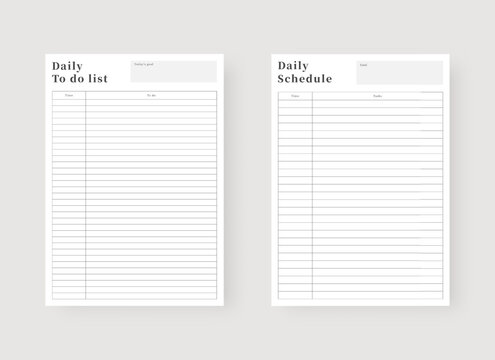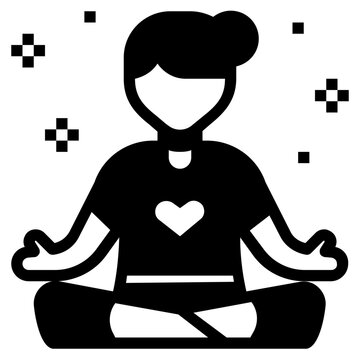10 Simple Steps for Establishing a Daily Routine That Works
Are you tired of feeling like you're constantly playing catch-up with your day? Creating a daily routine can help bring structure and balance to your life, allowing you to take control of your time and achieve your goals. In this article, we'll explore 10 simple steps to establish a routine that works for you. Whether you're looking to improve your productivity, reduce stress and anxiety, or simply lead a more balanced lifestyle, these tips will help you get started. So let's dive in and discover the power of routine!

Benefits of Having a Routine
Having a routine is essential to a healthy lifestyle. A routine can provide structure to your day, which can lead to numerous benefits for your physical and mental well-being. Here are some of the most notable benefits:
Improved Time Management
A routine can help you manage your time more efficiently by prioritizing tasks and activities. By setting aside specific times for work, exercise, self-care, and other activities, you can prevent procrastination and stay on track. This can also help you avoid burnout and maintain a healthy work-life balance.
Reduced Stress and Anxiety
A predictable routine can reduce stress and anxiety by providing a sense of stability and control. When you know what to expect each day, you can prepare yourself mentally and emotionally, reducing the likelihood of feeling overwhelmed or anxious.
Better Sleep Quality
A consistent routine can also improve your sleep quality. Going to bed and waking up at the same time every day can regulate your body's internal clock and help you fall asleep faster and stay asleep longer. This can lead to better energy levels and improved overall health.
Increased Productivity and Focus
A routine can help you stay focused and productive by minimizing distractions and interruptions. When you have a clear plan for your day, you can prioritize tasks and set realistic goals, leading to a greater sense of accomplishment and motivation. Additionally, by having a routine, you can establish healthy habits, which can make it easier to maintain focus and stay on task.

Planning Your Routine
Planning your routine is an essential step towards establishing a routine that works for you. Here are some steps to help you plan your routine effectively:
Identify Your Goals and Priorities
Start by identifying your goals and priorities. What do you want to achieve? What tasks and activities are most important to you? By understanding your priorities, you can create a routine that aligns with your values and aspirations. Make sure you consider both short-term and long-term goals.
Analyze Your Current Habits and Activities
Take a close look at your current habits and activities. What are you currently doing each day? What habits are serving you well, and which ones are holding you back? By analyzing your current routine, you can identify areas for improvement and make changes that will support your goals. You can also determine which habits to keep and which ones to let go of.
Create a Schedule and Set Realistic Expectations
After identifying your goals and analyzing your current routine, create a schedule that works for you. Start by setting aside blocks of time for work, exercise, self-care, and other activities. Be realistic and leave room for flexibility and unexpected events. It's also important to set realistic expectations for yourself. Don't try to cram too much into your day, or you risk feeling overwhelmed and discouraged. Remember, it's better to start small and build up gradually.
Use a Planner or Calendar
Using a planner or calendar can be helpful in planning and organizing your routine. It can help you stay on track and ensure that you don't miss important tasks or appointments. You can choose to use a paper planner or a digital calendar, whichever works best for you. Make sure to schedule regular reviews of your routine to make any necessary adjustments.
Prioritize Self-Care
Self-care is an important aspect of any routine. Make sure to include activities that promote your physical, mental, and emotional well-being. Examples include exercise, meditation, journaling, and spending time with loved ones. Prioritizing self-care can help you feel more balanced and energized throughout the day.
By following these steps, you'll be on your way to establishing a routine that works for you and helps you achieve your goals.

Establishing Your Routine
Establishing a routine means putting your plan into action. Here are some simple steps to help you do that:
Start Small with Achievable Tasks
When creating a routine, it's important to start with small and simple tasks to build momentum. Start with tasks that you can easily incorporate into your daily routine. With time, you can gradually add more challenging tasks and activities.
Include Healthy Habits and Self-Care Activities
A good routine should include healthy habits and self-care activities that support your physical and mental well-being. This can include exercise, meditation, journaling, or any other activities that help you feel energized and refreshed.
Track Your Progress and Adjust Your Routine as Necessary
To stay accountable and motivated, keep track of your progress and celebrate your achievements. It's also important to be flexible and adjust your routine as needed. If something isn't working for you, don't be afraid to make changes and try something new.
Stay Consistent
Sticking to your routine is key to achieving your goals. Try to maintain a consistent schedule and avoid distractions as much as possible. Remember, it takes time to establish a routine, so be patient and keep working at it.
Tips for Sticking to Your Routine
Establishing a routine is only half the battle. Here are some effective tips to help you stick to it:
Create a Supportive Environment
Create a supportive environment that encourages your routine. This can include setting up a dedicated workspace, finding a workout buddy, or enlisting a friend to hold you accountable.
Stay Motivated and Accountable
Staying motivated and accountable is crucial for sticking to your routine. Set specific, measurable, and achievable goals, and track your progress regularly. Use tools like habit trackers, journals, or apps to keep yourself accountable.
Celebrate Your Accomplishments
Finally, don't forget to celebrate your accomplishments. Treat yourself to a favorite meal, give yourself a day off, or indulge in a relaxing activity that you enjoy. Celebrating your accomplishments will help you stay motivated and committed to your routine.

Real-Life Examples of Successful Routines
If you're looking for inspiration on how to establish a routine, here are some real-life examples of successful routines that you can adapt to your lifestyle:
Morning Routines
- Wake up at the same time every day to establish a consistent sleep pattern.
- Drink a glass of water to hydrate your body after a long night's sleep.
- Stretch or do yoga to increase blood flow and flexibility.
- Meditate or journal to calm your mind and set intentions for the day.
- Eat a healthy breakfast to fuel your body with essential nutrients.
Work Routines
- Create a to-do list for the day to prioritize tasks and minimize stress.
- Set aside specific times for email and social media to avoid distractions.
- Take breaks every hour to stretch and move to prevent eye strain and fatigue.
- Stay hydrated and eat healthy snacks to maintain focus and energy.
- End the workday with a clear plan for the next day to minimize anxiety and help you start the next day with confidence.
Fitness and Exercise Routines
- Schedule workouts at the same time every day to establish a consistent exercise routine.
- Mix up cardio and strength training to challenge your body and prevent boredom.
- Take rest days to prevent burnout and allow your muscles to recover.
- Track progress and set goals to stay motivated and monitor your progress.
- Try new activities to stay engaged and prevent exercise plateau.
By following these examples, you can create your own successful routine that works for you. These routines are effective because they prioritize important tasks and activities, incorporate healthy habits and self-care practices, and provide structure and organization to the day.

Adapting Your Routine to the Seasons
Establishing a routine is essential, but it's also crucial to be adaptable and adjust your routine based on the changing seasons. During the summer, for instance, you may prefer to wake up earlier to take advantage of the cooler morning temperatures for outdoor activities. Conversely, in the winter, you may want to adjust your routine to include more indoor activities and self-care practices to combat the effects of seasonal affective disorder (SAD). By adapting your routine based on the season, you can optimize your productivity and overall well-being throughout the year.
When adapting your routine for different seasons, consider the following tips:
1. Keep an Eye on Daylight Hours
As the days shorten and lengthen, the amount of daylight available can significantly impact your routine. Be aware of the changes in daylight hours and adjust your sleep schedule accordingly. Consider using a dawn simulator or light therapy to regulate your body's internal clock.
2. Incorporate Seasonal Activities
Incorporating activities that are specific to the season is an excellent way to keep your routine fresh and exciting. During the winter, consider taking up skiing, ice skating, or snowshoeing. In the summer, consider activities such as swimming, hiking, or gardening.
3. Incorporate Seasonal Self-Care Practices
Each season presents its unique set of challenges and opportunities to take care of yourself. In the winter, for example, your skin may become dry and itchy, so moisturizing your skin is essential. In the summer, staying hydrated is critical, so make sure to drink plenty of water. Take advantage of the seasonal produce and include it in your diet. Eating seasonal fruits and vegetables that are rich in nutrients can help keep your body healthy.
By incorporating these tips, you can adapt your routine to the changing seasons, and make the most of each season.

Establishing a Routine with a Busy Schedule
Establishing a routine can be challenging, especially if you have a busy schedule. However, it is still possible to create a successful routine. Here are some tips to help you establish a routine with a busy schedule:
Prioritize Your Tasks
- Identify your most important tasks and ensure they are included in your routine.
- Break down larger tasks into smaller, more manageable steps to make them easier to accomplish.
Use Time-Blocking
- Consider using time-blocking to schedule your day in advance and make the most of your time.
- Allocate specific time slots for each task and try to stick to them.
Incorporate Self-Care Practices
- Incorporate self-care practices into your routine to help you stay calm and focused even during busy periods.
- Activities like meditation, yoga, or exercise can help you recharge.
Be Flexible
- Be flexible and willing to adjust your routine as needed to accommodate changes in your schedule.
- Remember that your routine should work for you, not against you.
Following these tips will help you establish a routine that works for you even with a busy schedule.
Personal Story
When I became a working mother of two, I found it difficult to establish a routine that worked for my busy schedule. I often felt overwhelmed and unproductive, unable to balance my work responsibilities with my family obligations. However, after reading about the benefits of having a routine, I decided to make a change.
I started by identifying my goals and analyzing my current habits and activities. I realized that I was spending too much time on social media, which was affecting my productivity, and not enough time on self-care and exercise, which was affecting my overall well-being. With a clear understanding of my goals, I started creating a schedule that included time for work, exercise, self-care, and family time.
I started small by incorporating short workouts into my morning routine and taking breaks throughout the day to stretch and move. I also made an effort to disconnect from social media during work hours and focus on my tasks. This helped me stay focused and motivated throughout the day.
Over time, I noticed a significant improvement in my energy levels and productivity. I felt less stressed and more in control of my day. I was able to complete my work tasks more efficiently, leaving more time for quality family time in the evenings.
By establishing a routine that worked for me, I was able to achieve a better work-life balance and improve my overall well-being. If you are struggling to establish a routine, I encourage you to start small and focus on your priorities. With time and effort, you too can achieve a routine that works for you.
As someone who has struggled with time management and productivity in the past, I am passionate about helping others establish routines that work for them. Through my own research and experience, I have found that having a routine can significantly improve one's physical and mental well-being. Additionally, studies have shown that having a routine can lead to increased productivity, reduced stress and anxiety, and better sleep quality. As a certified life coach and wellness enthusiast with a background in psychology, I am committed to providing evidence-based information and practical tips for establishing a daily routine that can help readers achieve their goals and live a more fulfilling life.
Comments
Post a Comment